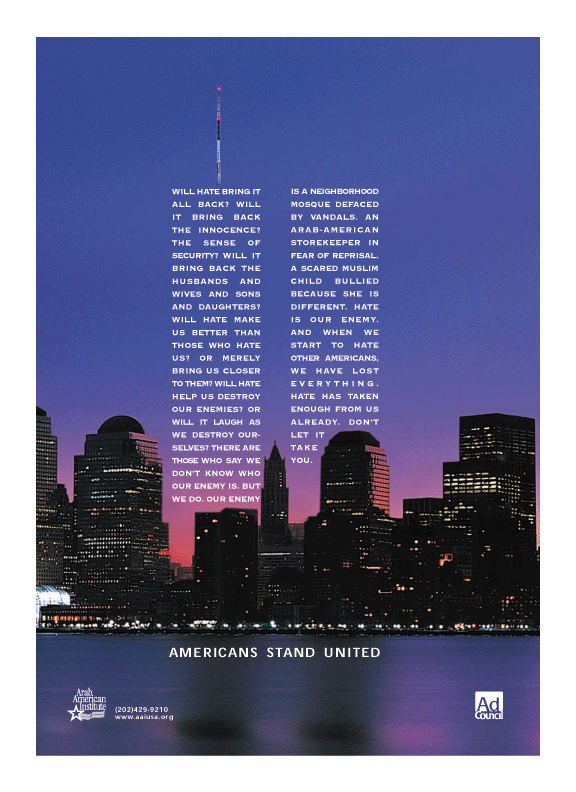|
|
|
ADC Press Release
ADC Condemns Hateful Depiction of Islam and Calls for Inquiry-
http://www.adc.org/index.php?id=2726
Washington, DC, February 2, 2006 -- Today the American-Arab Anti-Discrimination Committee (ADC) condemned a series of cartoons depicting Prophet Mohammed in a negative, hateful, and racist fashion. These racist attacks, that do nothing but perpetuate hate and violence against Muslims, were featured in the Danish newspaper Jyllands-Posten and reprinted in other European newspapers.
Furthermore, ADC called on the Office for Democratic Institutions and Human Rights (ODIHR) at the Organization for Security and Cooperation in Europe (OSCE) to initiate an inquiry into the growing controversy stemming from these depictions. The ODIHR is the body that addresses Islamophobia and Anti-Semitism in the 55-country-member OSCE which includes the United States, Canada, and EU-member nations among others.
While ADC calls on all parties to establish an open and constructive dialogue to address this issue, and opposes any acts of violence and retaliatory threats or attacks, ADC is very troubled that images of this nature are considered acceptable within normal public discourse in Europe. Hon. Mary Rose Oakar, ADC President, said, "The Arab and Muslim populations in the US and Europe continue to face hate-motivated violence and unlawful acts of discrimination as a result of the perceived acceptability of hatred toward Islam and Muslims," Oakar continued,"Tensions in recent months highlight the need to establish a tolerant public discussion to promote integration and understanding among all peoples. Hateful anti-Muslim images, just as Anti-Jewish images, are counterproductive and impede on the efforts of those working toward a just and equal society with respect for all faiths and ethnicities." ADC calls on newspapers and magazines to cease publication of these hateful images that malign the religion of 1.4 billion people around the world.
________________
ADC and the Arab American community of Philadelphia
is humbled and heartened by the many letters of
support we have received from our fellow Americans.
We wish to express our sincere appreciation and
solidarity. We also wish to reciprocate the support to all Americans, as we all go through this horrendous tragedy together.
ADC has set up a national fund for donations to the
victims of the September 11 terrorist attacks in New
York City and Washington, DC. All contributions made to the fund will be donated to the American Red Cross to assist the families of the victims.
These terrible events have affected all of us in America. The ADC would like to do its share to help
our nation cope with this tragedy. We hope that all
ADC members, supporters and friends worldwide will
contribute to this fund.
The special fund has been set up through the ADC
Research Institute (Federal tax identification number 52-1252206). The ADCRI is a 501(c)(3) educational and charitable foundation, and contributions to it are tax-deductible to the fullest extent permitted by law.
Checks should be made payable to:
ADCRI
September 11 Victims,
and mailed to:
ADC
4201 Connecticut Avenue, NW Suite 300
Washington, DC 20008
http://www.adc.org/ad_campaign/ad.pdf
http://www.adc.org/press/2001/15september2001.htm
We will get in touch with all of you for all our future educational events. We encourage your participation in educational activities and statements of similar support in the media.
We all stand together regardless of color or creed.
In Solidarity,
ADC-Philadelphia Chapter
***************************************************
Arab Americans are an ethnic group who trace their roots to the Arabic-speaking countries of the Middle East and North Africa. Arab immigrants began arriving in the United States during the 19th century. The majority of Arab Americans are descendants of the first wave of mostly Christian immigrants, which began around 1875 and lasted until about 1920. After a period when immigration was restricted, a second wave arrived after World War II. Today, most Arab Americans are native-born Americans. Their regional homelands include 22 Arab countries in southwestern Asia and North Africa, though most Arab Americans originate from Lebanon, Syria and Palestine. There are also substantial communities from Egypt, Yemen and Iraq.
Demographics
Currently there are three million Arab Americans who live in all 50 of the United States, 90 percent of whom live in urban areas. The cities with the largest Arab American populations are Los Angeles, Detroit, New York, Chicago and Washington, D.C., respectively. The largest communities of Arab Americans live in the Detroit/Dearborn, Michigan area.
Education and Employment
Eighty-two percent of Arab Americans hold at least a high school diploma, and 36 percent have a college degree. Approximately 65 percent of Arab American adults are in the labor force; 5.9 percent are unemployed, which is about the same rate of unemployment in the rest of the country. Though Arab Americans work in all occupations, nearly 73 percent of these working adults are employed in managerial, professional, technical, sales or administrative fields. At the local level, Arab Americans are most likely to be executives in Washington, D.C. and Anaheim, California; salespeople in Cleveland and manufacturing workers in Detroit. Arab American incomes are 22 percent higher than the U.S. national average.
Religion
The majority of Arab Americans are Christian. Only about 12 percent of Muslims worldwide are Arabs. In fact, there are more Muslims in Indonesia than in all Arab countries combined. Today, Arab Muslims represent the fastest growing, albeit still minority, part of the Arab American community. Religious practices that direct personal behavior--including the five-times-daily prayers, month-long fast at Ramadan, beards for men and the wearing of the hijab (headcover) for women make Muslims more visible than most religious minorities and thus more vulnerable to bigotry.
Ethnicity
The U.S. Census classifies Arabs as white along with the European majority, although a number of Arab Americans believe they are treated more like other ethnic minorities than European Americans. Although the federal government does not currently measure Arab Americans separately, some institutions like universities and health agencies do classify people of Middle Eastern ethnicity separately.
Stereotypes and Racial Profiling
Fueled by foreign policy and public ignorance about the Arab American population, negative stereotypes of Arab Americans have blossomed in American pop culture since the 1970s. The Arab characters in movies are often seen as the "bad guys" or terrorists, greedy sheiks or barbarians. But these prejudices are not just in the media. Crises in the Middle East have invited backlash against mosques and Arab-owned stores through the years. During the Gulf War, prominent activists and politicians of Arab descent were targeted by the FBI for questioning about pro-Iraqi terrorism in the U.S. Within three days after the Oklahoma City bombing, more than 200 hate crimes were committed against Arab Americans and American Muslims. The same was true in the days following September 11.
After 9/11, anti-terrorism policies of airline passenger profiling have disproportionately affected Arabs and Muslims. Some have been taken off planes or not allowed to board because of their ethnicity. Anti-terrorist programs and policies that single out people of Arab descent have also contributed to creating negative bias in the public eye, not to mention fear of the police and hesitation to report hate crimes among Arab Americans.
Find out when it will be aired on your Public TV Station http://www.pbs.org/itvs/caughtinthecrossfire/
|
| |
|

"But then, nothing, nothing justifies Terrorism"
~Mahmoud Darwish, Palestinian poet~
The catastrophe that hit Washington and New York has only one name-the Madness of Terrorism. This catastrophic event was neither a dark science fiction film nor was it the Day of Reckoning. It was terrorism that is country-less, colorless, and creedless, no matter how many names of gods, deities and agonies of man it may have enlisted in order to justify itself.
No cause, not even a just cause, can make legitimate the killing of innocent civilians, no matter how long the list of accusations and the register of grievances. Terror never paves the way to justice, but leads down the shortest path to hell. We deplore this horrendous crime and condemn its planners and perpetrators with all the terms of revulsion and condemnation in our lexicon. We do this not only as our moral duty, but also in order to re-assert our commitment to our own humanity and our faith in human values that do not differentiate between one people and another. Our sympathy with the victims and their families and with the American people in these trying times is thus an expression of our deep commitment to the unity of human destiny. For a victim is a victim, and terrorism is terrorism, here or there, it knows no boundaries nor nationalities and does not lack the rhetoric of killing.
Nothing, nothing can justify this terrorism that melds human flesh with iron cement and dust. Nor can anything justify polarizing the world into two camps that can never meet: one of absolute good, the other of absolute evil. Civilization is the result of world societies contributing towards a global heritage. The accumulation and interaction of which leads towards the elevation of humanity and nobilility of consciousness. In this context, the insistence of modern-day orientalists that terrorism resides in the very nature of Arab and Islamic culture, contributes nothing to the diagnosis of the enigma and thus offers no solution. Rather, it makes a solution more enigmatic because it becomes caught in the grip of racism.
Therefore, when America searches for reasons to explain the animosity towards its politics (an animosity not held towards the American people and their globally popular culture), it must distance itself from the concept of the "conflict of cultures". It should also dispense with the need to identify an ever present enemy, necessary to test "western supremacy". Instead, it should move into a political arena, where the United States can meditate on the sincerity of its foreign policy. In particular it should reflect on its success in the Middle East, where the great American values of freedom, democracy and human rights, have stopped functioning -- especially in the Palestinian context where the Israeli occupation remains free from answering to international law while the U.S. provides it with what it needs of rationalizations and justifications for practices which border on "state terrorism".
We know that the American wound is deep and we know that this tragic moment is a time for solidarity and the sharing of pain. But we also know that the horizons of the intellect can traverse landscapes of devastation. Terrorism has no location or boundaries, it does not reside in a geography of its own, its homeland is disillusionment and despair.
The best weapon to eradicate terrorism from the soul lies in the solidarity of the international world, in respecting the rights of all peoples of this globe, to live in harmony and by reducing the ever increasing gap between north and south. And the most effective way to defend freedom is through fully realizing the meaning of justice. Security measures alone are not enough since terrorism carries within its folds a multiplicity of nationalities and recognizes no boundaries. The world cannot be divided into two societies, one for the rebels and the other for the officers of the law. But then, nothing, nothing justifies Terrorism.
|
| |
|
 " I have been here since the beginning, and I shall be here until the end of days; for there is no ending to my existence. The human soul is but a part of a burning torch which God separated from himself at creation." ~Khalil Gibran~
" I have been here since the beginning, and I shall be here until the end of days; for there is no ending to my existence. The human soul is but a part of a burning torch which God separated from himself at creation." ~Khalil Gibran~
|
| |
|
|
|
|
|


